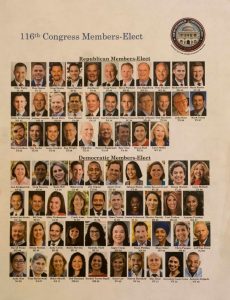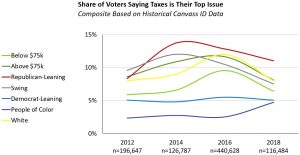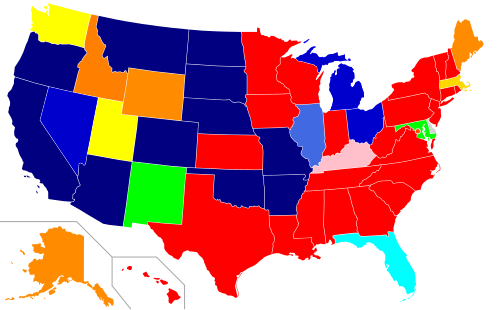An important new study of “The Battleground: Democratic Perspective,” featuring strategic analysis by Celinda Lake, Daniel Gotoff and Corey Teter, reveals key vulnerabilities and opportunities for Dems as the 2020 campaign begins.
The Lake Research Partners study finds widespread “economic anxiety” and an “ever-deepening sense of frustration toward the status quo in Washington,” along with a “sense of alienation among voters,” which “appears unlikely to improve without serious and bold economic initiatives from the Democrats.” Further,
Democrats’ strong showing in the 2018 midterms was a solid step toward rehabilitation from the disastrous 2016 elections, though it would be a mistake to treat those results as a necessary predictor of success moving forward. In fact, despite the President’s historic levels of unpopularity, voters continue to profess favorable opinions of his stewardship over the economy and job creation (a qualified assessment, to be sure, given their expectations of yet another significant downturn); moreover, they tend to side with Republicans over Democrats on these issues,as well. Overall, this data continues to illustrate Democrats’ inherent weakness to respond on the economy, and if the Party does not rectify this soon,it will find itself in serious jeopardy for the 2020 election.
Indeed, Democrats still face the challenge of articulating a bold, compelling economic vision that rises above the safety of platitudes, or that seeks to convince voters that a reprise of the economy of the 1990s or the early 2010s is sufficient to address the scale of the economy’s persistent failings—a perilous gambit that cedes the dimension of change to the opposition and ignores voters’ fears and their aspirations for the future. Democrats have major advantages on healthcare and education which contributed largely to their success in 2018. The challenge facing the Party ahead is to translate those advantages into a bigger economic frame…Democrats stand to profit immensely by capitalizing on the President’s and his Party’s glaring vulnerabilities regarding their ties to the same powerful special interests that dominate American politics and government and are at the root of voters’ desire to chart a decidedly new course. Pursuing these strategies will require more than just highlighting the President’s flaws ;they will require some measure of risk from Democrats as they offer a bold new trajectory and true security – economically, domestically, and internationally – for the American people.
In addition, “fully 59% of voters say they are either “very” or “somewhat” worried about the country suffering an economic downturn in the near future.” Also, “majorities of voters who identify as middle class (58% very/somewhat worried) and as working class (63% very/somewhat worried) are more fearful than not about the prospects of an impending recession.”
Although 54 percent of voters have a positive view of their members of congress, “Overall, 24% of voters say their member of Congress is not supportive enough of Trump compared to 18% who say they are too supportive.” But Trump’s popularity numbers are highly problematic for Republicans:
Only four-in-ten(40%) voters currently have a favorable opinion of the Presiden tcompared to 55% who view him unfavorably. The intensity of the animosity towards Trump is also quite stunning, as 48% of voters have a “strongly” unfavorable opinion of the President compared to only 27% who have a“strongly” favorable opinion of Trump. The President’s personal profile is also heavily underwater amongindependents, with 57% viewing him unfavorably, including 43% who feel that way “strongly.”
The President’s job approval ratings largely mirror those of his personal image, with 43% of voters currently approving the job he is doing as President, compared to 52% who disapprove. And while the President continuesto enjoy near-universal levels of approval among his Republican base (92% approve), his support among independents is solidly net-negative (32% approve, 51% disapprove), with independent women (30% approve, 57% disapprove) in particular holding very negative views about his tenure to date. Trump’s low ratings among these voters represents a significant obstacle for his administration moving forward as he tries to broaden his base of support. To no one’s surprise, Democrats display almost universal displeasure with the President (93% disapprov e), including a staggering 85% who say they disapprove “strongly.”
As has been the trend since he was elected, African Americans (83% disapprove, incl. 69% “strongly”disapprove) and Latinx voters (69% disapprove, incl. 59% “strongly” disapprove) continue to be amongthe President’s strongest detractors. There is also a very large gender gap with men —of whom 50% approve and 46% disapprove—and women—of whom 37% approve and 60% disapprove. And while thePresident’s rating among seniors is somewhat mixed (45% approve, 50% disapprove) his ratings amongmillennials (34% approve, 58% disapprove) is an ominous sign for the Republican Party’s future, and highlights the complexity of the GOP’s challenge, which continues to be not just racial , ethnic, and along gender lines, but generational too.
With respect to leading issues, the study notes that “a majority of voters disapprove of Trump’s handling of health care(33% approve, 58% disapprove), immigration (41% approve, 56% disapprove), and foreign affairs (41% approve, 54% disapprove).” There appears to be a split verdict on his “handling of taxes,” with 45 percent approving and 47 percent disapproving.
The study finds that Trump’s “trust-deficit” on health care provides “one of the Democrats’ strongest advantages going forward—though Democrats will need to offer a strong alternative in order to leverage this advantage in the context of a presidential election, which is much more a choice between two competing visions than a referendum on a president’s first term.” The study also finds a 9-point edge for Democrats on immigration, which the authors call “quite remarkable,” considering Trump’s incessant flogging of the issue.
However, Trump has a significant advantage at present on one of the most most important issues — the economy. As the Lake study observes, “Since the last Battleground Poll, the President has increased his economic job performance numbers by 6-points (51% approve in previous battleground poll), with a 57% majority of voters now saying they approve of his economic stewardship compared to 38% who disapprove. Equally as important, a similar majority (57%) also says it approves of his work on job creation, a 5-point increase from the previous poll (52% approve in the previous Battleground Poll).” Also, 72 percent of white blue-collar workers expressed approval of his job on the economy, a big red flag for Dems in key swing states. Also,
As a result of his strong numbers, voters also currently trust the President more than Democrats on moving the economy forward (52% trust Trump vs. 40% trust Democrats) and future job creation (50% trust Trump vs. 39% trust Democrats). In a troubling sign for Democrats, Trump is trusted more on these two vital issues by a number of important swing constituencies, including independents (+35oneconomy, +37 on jobs), white women (+8 on economy, +8 on jobs), and self -described moderate voters (+19 on economy, +20 on jobs). Voters place more modest levels of trust in Trump over Democrats on the issue of National Security(47%to43%), but it is his advantage on the economy and jobs that poses the greatest challenge for Democrats, particularly as Democrats have never won the White House when trailing on this central front.
As for the image of the Democratic Party, “Currently, more voters have a negative view…(43% favorable, 46% unfavorable), including pluralities of independents (21% favorable, 44% unfavorable) and self-described moderate voters (29% favorable, 41% unfavorable).” In terms of the generic congressional ballot,
Currently, the Democrats hold a five-point advantage in a 2020 generic congressional ballot (Dem 42%, GOP 37%), which is down slightly from the eight-point lead they held before the 2018 midterms. The gender gap seen in previous Battleground Polls also remains alive and well, with women supporting the Democrats by an 18-point margin (Dem 48%, GOP 30%), and men the Republicans by a 9-point margin (Dem 35%, GOP 44%). The marital gap is perhaps even more stunning: marriedmen are voting Republican by a 16-point margin (Dem 34%, GOP 50%), while married women are split (Dem 39%, GOP 38%). Single women are voting Democratic by an enormous 54-point margin (Dem 65%, GOP 11%), and single men by 10 points (Dem 43%, GOP 33%). Independents, meanwhile, appear completely up for grabs, with a whopping 68% of these voters fully undecided. And while self-described moderate voters currentlyprefer Democrats by a 13-point margin (Dem 30%, GOP 17%), a 52% majority of these voters are also uncommitted.
Democrats continue to lead among their traditional base targets such as millennials (Dem 45%, GOP 32%), African Americans (Dem 67%, GOP 7%) and Latinx voters (Dem 58% to GOP 27%). Continuing the trend from recent Battleground Polls, Democrats also remain the preferred choice of voters with a college education (Dem 46%, GOP 30%), including a staggering 23-point lead among college-educated women (Dem 50%, GOP 27%). Democrats also hold a 9-point advantage among college-educated whites (Dem 44%, GOP 35%), the same margin we saw in the previous Battleground Poll…
Regarding the white working-class, “Republicans continue to hold a double-digit advantage among non-college educated whites (Dem 26%, GOP 54%), with this group showing no signs of a shift since the last Battleground Poll (Dem 32%, GOP 54% in March 2018).”
Going forward, Lake, Gotoff and Teter recommend that Democrats can improve their position on the economy and jobs by “exposing how Republicans’ economic policies have focused more on appeasing wealthy special interests at the expense of most American people—a point bolstered by the findings that voters trust Democrats more than Republicans when it comes to dealing with special interests (42% trust Dems vs. 28% trust GOP)…it is imperative that Democrats develop a strong economic platform that employs a clear anti-special interest frame, contrasts with Republicans, and appeals to and energizes voters to show up in record numbers next November.” They conclude:
Given the high levels of dissatisfaction with the direction of the country and the country’s political leaders, the American electorate remains fundamentally change-oriented. And while the President’s unpopularity certainly continues to present opportunities for the Democratic Party moving forward, attacking Trump will not be enough, particularly with a significant number of voters seemingly able to reconcile their misgivings about Trump with positive ratings of his handling of the economy. As 2020 continues to come closer into focus, Democrats will be best served by advancing an audacious, forward-thinking agenda that takes on the powerful special interests and delivers real change for the American people, exploiting the dimensions where the Party already enjoys advantages (though has failed to capitalize with proposals that tinker around the edge of real reform) and advancing on terrain where they continue to trail (i.e. the economy).
Although the economy and jobs remains a potentialy-pivotal wild card leading up to the 2020 elections, Democrats would be well-served to focus on the Lake Research recommendations, which can strengthen the Party’s “brand” in any case.














